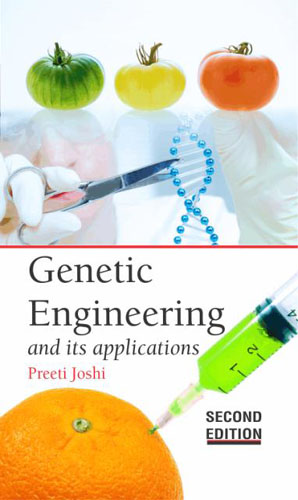Genetic Engineering And Its Applications (2nd Ed.) (pb)
But nothing can be accomplished until scientists have identified the relevant genes, figured out what they do, and figured out how the proteins they make work in the organism.
Genetic engineering is the method to transfer a gene from the DNA of one species to the DNA of another species. Genetic engineering gets to the very core of how life works and people are inclined to have very strong feelings about it. Genetic engineering was probably the most important scientific event of the 20th century. It was the discovery of by James Watson and Francis Crick (1953), of the structure of the DNA molecule, which is the basis of heredity. Darwin had shown how species might have changed over eons by slow, random natural processes. Watson and Crick gave us the key moving evolution along much faster, to suit our own purposes.
A DNA molecule is like a string of letters, using a four letters alphabet, easily copied when living cells reproduce. The sequences of letters make sentences, which we call genes. One kind of gene gives a cell the necessary auctions for making one of the various kinds of protein, used for structures, enzymes, signals, all the basic mechanisms of life. The other kind sequence is used as a control mechanism so that a cell can tell when to make which proteins and when to do something else.
Scientists learned the language of protein-making gene sequences. This language is the same for all forms of life. Gene sequences control sequences and are like switches that turn other genes on or off. A control sequence could have different results in different organisms. Some control genes are used to turn another gene on, and others are used to turn another gene off and some control genes turn other control genes on or off.
For example a cell needs protein A, but not in much amount. If the gene that If Is the cell to make protein A is turned on, eventually the control gene will sense that there is lots of protein A available, then it will turn off the protein making gene. Later when the supply of protein A has is used, the control gene will relent and let the protein making gene turn back on. One should know the answer of: (1) What sequence of letters make up the protein-making gene? (2) What sequences make up the control genes which turn it on or off!, (3) here they are situated on the chromosome! What signals activate the control genes! (4) Chemical reactions in which the protein molecule takes part? And (5) How those chemical reactions relate to some activity of the cell?
Each different organism has tens of thousands of different genes and makes a huge number of proteins. Life is enormously complex, however, hundreds of genes are now understood completely. There are many more genes, which have been discovered and associated with some function, but not yet understood very well.
There are practical applications of this knowledge. The first practical applications were in medicine, using genetically modified bacteria to make medical drugs such as interferon, human growth hormone and human insulin. The second kind of application was to modify organisms for agricultural purposes. It is this second application that will occupy us now.
The present text is an attempt to answer above and many other questions of genetic engineering.
Joshi P
555
Table of Contents..
- Introduction
- Gene Organization and Expression
- Enzymes in Genetic Engineering
- Gene Cloning Vectors
- Gene Isolation, Identification and Synthesis
- Cloning of Specific Gene
- Specific Gene Transfer
- Expression of Induced Genes
- Applications of Genetic Engineering
- Perspectives
- References
Book Details
Book Title:
Genetic Engineering And Its Applications (2nd Ed.) (pb)
Genetic Engineering And Its Applications (2nd Ed.) (pb)
Book Type:
TEXTBOOK
TEXTBOOK
No Of Pages:
352
352
Color Pages :
0
0
Color Pages :
0
0
Book Size:
DEMY (5.5X8.5)
DEMY (5.5X8.5)
Weight:
450 Gms
450 Gms
Copyright Holder:
All Rights Reserved
All Rights Reserved
Imprint:
STUDENT EDITION
STUDENT EDITION
Readership:
PG STUDENTS | UG STUDENTS |
PG STUDENTS | UG STUDENTS |
Associated Subjects:
Agricultural Sciences , Life Sciences , Pharmacy , Veterinary And Animal Sciences ,
Agricultural Sciences , Life Sciences , Pharmacy , Veterinary And Animal Sciences ,












